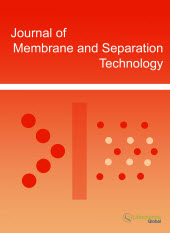jmst
|
|
Abstract: The paper deals with extraction of lithium by means of two capacitive deionization systems: one composed of lithium selective electrode and second with electrode wrapped with Li-selective membrane. In the case of the first system, hybrid electrodes where obtained by mixing λ-MnO2sorbent with activated carbon .The best Li-capacity was determined for electrode with 20 wt.-% of manganese oxide. For larger amounts of λ-MnO2 the electrode capacity decreased significantly. The second system was composed of carbon electrodes wrapped with ion-exchange membranes. The lithium selective membranes were synthesized by plasma induced interpolymerization of (meth)acrylic monomersinpores of Celgard 2400 support. Two functional monomers, poly(di(ethylene glycol)methyl ether methacrylate) and poly(glycidylmethacylate modified with hydroxymethyl-12-crown-4) were copolymerized with acrylic acid. It was found that the extraction of lithium chloride was the best for membrane caring copolymers of acrylic acid and glycidyl methacrylate modified with crown ether, andit was better than for membranes with sole poly(acrylic acid). Keywords: Capacitive electrode, lithium selective membrane, lithium recovery, pore-filled membranes.Download Full Article |
|
|
Abstract: This study presents a new concept of a simple method for the synthesis of dual layer hydrophilic/hydrophobic composite membranes for membrane distillation (MD). The membranes were prepared of poly(vinylidenefluoride) (PVDF) by phase inversion. The synthesis was realized by allowing a full or partial penetration of the polymer solution through one or two non-woven support (NWS) layers. This was achieved by proper selection of a thin NWS having high stiffness, high porosity and low surface tension, in combination with a runny polymer solution and sufficient time gap between casting and coagulation. The applied preparation method was effective in yielding dual layer composite membranes. The first layer atop the NWS was a hydrophilic or slightly hydrophobic one (contact angle (CA) of 88-92º), while the bottom layer beneath the NWS was highly hydrophobic (CA=132-140º). The difference in surface energy between the top and bottom layers originated from a difference in morphology. A smooth and dense top layer is formed as a result of an instantaneous demixing, while a porous and multi-scale network with some degrees of spherulitical structure was formed on the bottom by a delayed demixing mechanism. Direct contact MD (DCMD) results showed that the obtained flux was comparable to other composite MD membranes with high salt rejection. Membrane alignment inside the MD module is a critical element in determining the membrane performance and is shown to significantly increase flux when a top facing feed configuration is used. Keywords: Membrane distillation, poly(vinylidenefluoride), phase inversion, dual-layer, composite membrane.Download Full Article |
|
|
Abstract: The control of surface roughness of polyvinylidene fluoride (PVDF), polyethersulfone (PES), polysulfone (PS) and cellulose (CE) membranes was attempted by changing the rate of nonsolvent influx in the phase inversion process. PVDF and CE were chosen to represent membranes of high hydrophobicity and hydrophilicity, respectively, while PES and PS were chosen to represent membranes of intermediate hydrophobicity/-philicity. The concentration of sodium chloride (NaCl) in the aqueous coagulation medium was increased from 0 to 1.9 mol/L to decrease the rate of nonsolvent (water) influx in the solvent/nonsolvent exchange process. As well, the effect of polymer concentration and solvent on the surface roughness was investigated with respect to PVDF and PES. It was observed that the membrane surface roughness increased and decreased, respectively, for the hydrophobic PVDF and hydrophilic CE membrane as the rate of nonsolvent influx was decreased. For the PES and PS membranes of intermediate hydrophilic/-philicity, no significant roughness change was observed. The surface roughness tended to increase as the solution viscosity decreased. It was also observed that the pattern wave length of the hydrophobic membrane did not change significantly while that of the hydrophilic membrane increased significantly as the solvent influx rate was reduced. This trend is predictable by considering the shrinking or swelling of the cast polymer solution during the solvent/nonsolvent exchange process. Keywords: Surface roughness, pattern wave length, hydrophobicity/-philicity, AFM, nonsolvent influx rate, membrane..Download Full Article |
|
|
Abstract: Helix wave hollow fiber membranes are promising candidate to mitigate fouling and polarization effects in membrane operations. Current study describes a novel but simple approach to synthesize hollow fiber membranes with helix wave configuration. Poly(ether sulfone) (PES) based helix-waved hollow fiber membranes have been fabricated by dry-wet phase inversion process by using asymmetric coagulation conditions. Frequencies of the wave cycle have been observed approximately 20 and the wave length 7.1-7.6mm under the specifically required operating conditions defined by dope solution extrudate rate of 1g/min through 4cm of air-gap heights with 8.6m/min of winding speeds. On the other hand, simple hollow fibers are formed when the elongation force exerted by the winder is much higher than the surface tension of the external coagulant. The process can be useful for making polymer fibers for other applications as well. Keywords: Helix wave, hollow fiber membranes, poly (ether sulfone), asymmetric coagulation.Download Full Article |
|
|
Abstract: The effect of a microwave irradiation at 2450 MHz on the swelling and permeation properties of a Nafion membrane in water and methanol media has been studied. The influence of the irradiation power and the exposure time has been analyzed. The results found show that the irradiation hardly affects the membrane liquid uptake, but it affects the expansion properties of the membrane. The hydraulic permeability coefficient of the unmodified and the irradiated membranes has been experimentally determined. Higher hydraulic permeability has been obtained for the irradiated membranes in both water and methanol, but the degree of increment in permeability coefficient with microwave depends on kinds of permeation liquid. The results have been discussed considering the degradation effect occurring on the membrane hydrophobic matrix, which affects to the membrane elastic properties. Keywords: Nafion membrane, microwave, hydraulic permeability, swelling, liquid uptake, water, methanol. Download Full Article |


